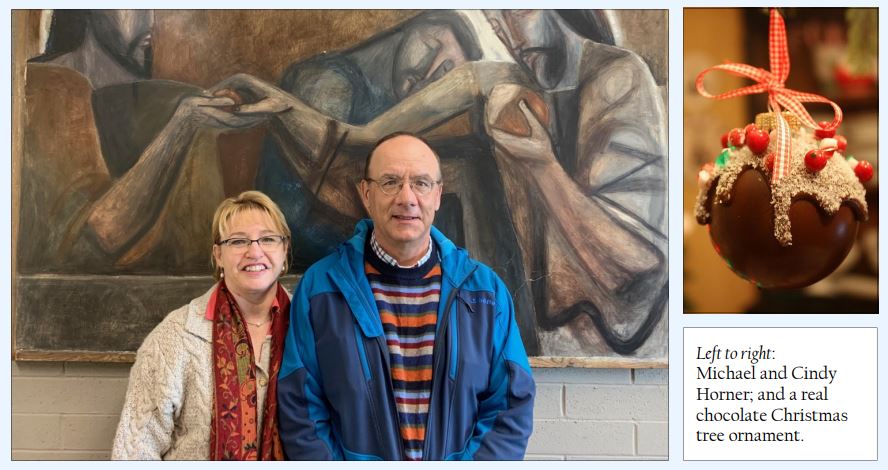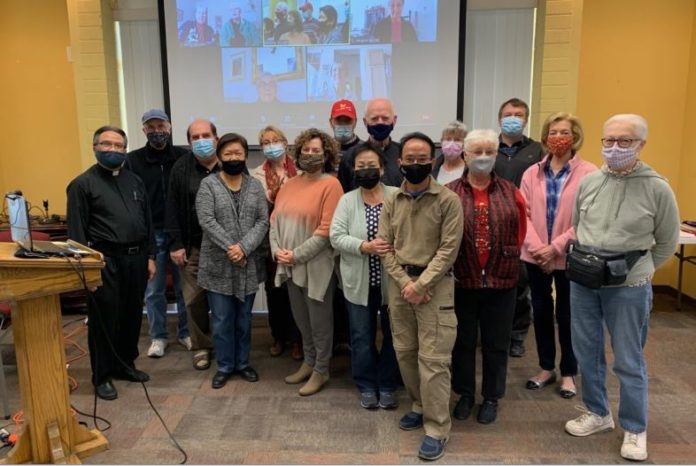by Anthony Nguyen, C.Ss.R. / DenverLink
The Advent Season always ushers in a special atmosphere and spirit, with its beautiful decorations at homes, churches and the main streets of every city in the USA. Music of the holiday season is played everywhere people gather for shopping, dining and entertaining. We enjoy familiar music, a Christmas tree, a wreath, and the four candles that represent the Advent messages of Hope, Peace, Joy, and Love at church. The three main tasks of the Advent Season are: anticipating the birthday of Christ; preparing ourselves for the second coming of the Messiah; and being grateful for the presence of Christ in the Eucharist.
Different cultures practice unique customs during the Advent Season. Many Asian countries use the Star Lantern to convey the spiritual meaning of Christmas. Other cultures celebrate the nine days before Christmas. These customs can enrich our own Christmas celebrations to help fill us with the blessings of Hope, Peace, Joy and Love that our Messiah brings to the world on Christmas Day. I’m very grateful to the parishioners of Our Lady of the Desert Conventual Church in Tucson who were willing to share their unique cultural Christmas celebrations with us. Enjoy!
Brittany, France

Florence and Pierre Renault; Las Posadas; and Ken and Luci Becker. Photos submitted by Fr. Anthony Nguyen
Growing up in Brittany, France in a secular family, I still remember Christmas being warmly celebrated. The Christmas tree was erected and well decorated a couple of weeks before the holiday. Early on Christmas Eve, the children would polish their shoes and place them in front of the fireplace. The family gathered for a delightful early Christmas Eve meal. Shortly before leaving for Midnight Mass, each family member would receive one token gift. No presents were under the Christmas tree at this time. The family then proceeded as early as possible to Midnight Mass so we could enjoy the carols sung by the choir accompanied by a magnificent organ. Upon returning from Midnight Mass, the family gathered again to enjoy some pastries. The children were then sent to bed so the parents could finish decorating and place the gifts under the tree.
Florence & Pierre Renault
Mexico
Being of Hispanic descent and born and raised in Tucson offered us a huge opportunity to appreciate the Mexican tradition of Las Posadas, which represents the nativity story. Las Posadas begins on December 16 and ends on Christmas Eve. The nine days represent the nine-month pregnancy of Mary, the mother of Jesus Christ. This celebration has been observed for over 400 years in Mexico and in other parts of Latin America. It has come to the USA as well, as many Hispanics still observe this Christmas tradition. Las Posadas begins with a procession which represents the journey of Mary and Joseph from Nazareth to Bethlehem, and their search for a place to stay. Two people dressed as Mary and Joseph are in the procession, as well as adult attendants and children dressed as angels. A nativity scene built to be carried in the procession may also be included. Each evening, this procession walks to houses – representing inns – along the way. At each house along the procession path, the Mary and Joseph actors ask if there is “room at the inn.” The residents of the house greet them with prayers and/or food as they send them on their way to another “inn.” The procession group sings hymns or Posada songs, which are often led by a priest. This procession is enacted for nine nights. On the last night – Christmas Eve – Mary and Joseph are finally welcomed into a home (the “inn”) and a feast of food, gifts, music and pinatas are shared by all.
Luci & Kent Becker
 Poland
Poland
We have celebrated three Polish traditions in our family: the Extra Place Setting, the Candle and Oplatek. The extra place setting is placed at table to represent the spirit of Christmas. If an unexpected guest arrives during dinner, he is thought to signify the Spirit of Christmas in disguise and is invited to sit at the extra place and join the family dinner. The candle signifies that Christians live in the home and welcome the Spirit of Christ. Oplatek is a white wafer that is placed on the table. Whenever everyone is together or seated at the table, the wafer is passed around and each person takes a piece. Then, everyone eats the wafer piece and wishes each other good health and happiness, and they give each other a hug and/or kiss. There is also a pink wafer, which in the past was taken to the barn and shared with the animals and pets of the home. The Polish people have respect for the oplatek, which often called the “Bread of Love.”
Lynn Kozubal
Vietnam
The Advent Season is a time to wait, expect and prepare for the birth of Christ the Savior. In Vietnam, preparations are obvious, with festive Christmas Cards with holiday scenes sprinkled with glitter and radio stations playing traditional Christmas music known throughout the world, but sung in Vietnamese. Even for non-believers, the cool air adds to the atmosphere of Joy, Hope, Peace and Love. The most impressive symbol for welcoming the season is the gathering of believers and non-believers at Catholic cathedrals to celebrate in unison and to revere in the grand light shows surrounding the area. Catholic families make a 20-inch star-shaped lantern with colorful cellophane paper so that a single bulb of light inside will shine through. These lanterns are proudly displayed high up on the roofs of their homes to show that the family is waiting with expectation for the birth of Jesus. Very humble and yet powerful.
Khue & Cuong Tran
 The Philippines
The Philippines
Two Philippine Christmas traditions are still well practiced both in the Philippines and by Filipinos abroad. Filipinos start the Christmas season making paper Christmas Star lanterns, or “parol.” These lighted parols are hung at windows or front doors of homes. The welcome light is for the traveling St. Joseph and Blessed Mother Mary who are looking for a place to stay. The lighted star lantern, which symbolizes the Star of Bethlehem, also decorates the churches to celebrate another tradition – Simbang Gabi or Misa de Gallo. The Simbang Gabi is a nine-day novena of early morning (3:00 am and 5:00 am) Masses on December 16-24. This practice was brought by the Spaniards for field laborers to attend Mass in honor of the Annunciation and start the Christmas season. The Simbang Gabi tradition is for everyone and has endured all this time. Vendors selling Filipino delicacies like rice cakes (puto, suman, etc.) and warm drinks like coffee, hot coco, and ginger tea called salabat wait outside, offering a real treat for churchgoers.
Sam & Maria Paz Ricalde-Shummon
Eastern Europe
The Legend of the Christmas Spider explains the origin of tinsel on Christmas trees. It is most prevalent in Western Ukraine, where small ornaments in the shape of a spider are traditionally a part of the Christmas decorations. According to legend, a poor but hardworking widow lived in a small hut with her children. One summer day, a pine cone fell on the earthen floor of the hut and took root. The widow’s children cared for the tree, excited at the prospect of having a Christmas tree by winter. The tree grew, but when Christmas Eve arrived they couldn’t afford to decorate it. The children sadly went to bed and fell asleep. Early the next morning, they woke up and saw the tree covered with cobwebs. When they opened the windows, the first rays of sunlight touched the webs and turned them into gold and silver. The widow and her children were overjoyed and never lived in poverty again. In Germany, a glass pickle ornament is always the last ornament hung on the tree for good luck. Children always search for the pickle first, for whoever finds that special ornament receives an extra gift from St. Nicholas.
 Switzerland
Switzerland
My mother with Italian roots grew up with her family in Zurich, the biggest town in little Switzerland. Before Advent began, she bought a magnificent pine tree from Norway which she decorated with a lot of love: simple and delicate ornaments, angel hair (fiberglass), a few silver strings, and real candles attached to the tree by special clips and candle holders. On top of the tree was the angel Halleluiah. But what we kids were most interested in wasn’t the angel hair, but the delicious real Swiss chocolate tree ornaments in form of bells, pinecones, and much more.
As a boy I spent hours observing my father’s hand-made nativity that had its special place depicting a simple stable and the Holy Family, radiating with sincere humble beauty. On January 6th, my mother put out the three kings to join the Holy Family, the shepherds and all the animals.
On Christmas Eve, our excitement reached a peak, for we knew it’s the evening where we exchange presents. My mother went in the living room for the final preparations. We knew that when she rang the bell we could go in. Opening the door as the bell rang aloud, we saw that my mother had lit the candles (with real flames!). This was the magical moment that danced within me and gave such joy, peace, and hope! I’ll never forget it! The air wafted with pine, candles, vanilla and cinnamon cookies. Before we could touch anything – presents included – we sang at least two favorite Christmas songs, accompanied by family members on instruments like the flute and the guitar. We followed the sharing time by a simple yet very joyful meal of barley soup and ham. My parents then had to rush out to join the church choir for Midnight Mass. My brother, sister and I could accompany them at the 10:00 am Christmas Mass. The church was full; so much so, that many people had to stand.
For the special Christmas occasion, a professional ensemble of singers and musicians joined the regular choir. It was like the choirs of Heaven had come down to perform just for us! The choir’s director was a priest, Vicar Roth, who was a genius musician (and the priest who baptized me four days after my birth). The most wonderfully memorable music for me was the “Transeamus” from Joseph Schnabel. Transeamus means “let us go across!” (from worldly to heavenly things). Indeed, the music transported my heart high to welcome once again the Christ Child into my life – Listen here.
Christmas traditions in Switzerland with my family were a magical time of joy, peace, hope, and LOVE. We wish you a blessed Christmas … with Christ Jesus our mighty Savior!
Michael & Cindy Horner
Credit: DenverLink, update December 11, 2020.






